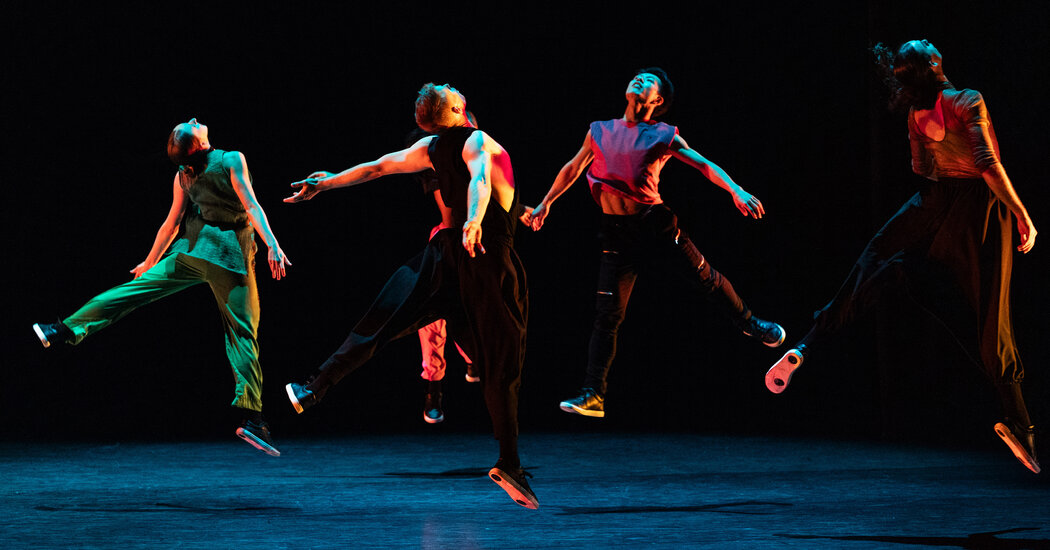When a repertory company comes to town with two programs, and one has a Rennie Harris dance on it, choose that. This Philadelphia hip-hop choreographer is a treasure and so are his dances.
“Dear Frankie,” the rousing closer to a program by Hubbard Street Dance Chicago, was such a poetic wonder — in sound, in look, in stillness and in action — that it almost made up for what had come before it. Almost. It was a long night.
Hubbard Street, now in its 46th season, returned to the Joyce Theater on Tuesday for a two-week run. (The program next week features works by Lar Lubovitch, Rena Butler and Aszure Barton.) Now under the artistic direction of Linda-Denise Fisher-Harrell — a former company member who went on to be a much admired Alvin Ailey dancer — the group presented the New York premiere of Harris’s “Dear Frankie” along with works by Darrell Grand Moultrie and Thang Dao.
In “Dear Frankie,” Harris pays homage to a pioneer of Chicago’s house culture, the D.J. Frankie Knuckles. Known as the “godfather of house,” he was pivotal in introducing the genre to the world. The dance starts off slowly yet stylishly: James Clotfelter’s lighting immediately transports us to a club where, every so often, bright white beams flood light onto the stage. It’s so stark, so subtle in how it encloses the space, turning it into a haven.
At first dancers cluster at the center of the stage, but gradually they wander off, gliding together in small groups as they tickle the floor with footwork before slipping into other constellations of bodies. In these brief fragments, like tiny chapters building up to a book, the dancers find their bearings as the beat begins to soak into their skin. At one point, Abdiel Figueroa Reyes lets loose, his limbs rippling like spun silk.
Beyond steps, glorious as they are, Harris is passing on Chicago house culture. In a series of voice-overs, he and others describe the importance of the dance club the Warehouse, where people discovered freedom through movement and found their chosen families.
The dancers’ footwork starts out in fits and spurts, becoming more intricate, more full-bodied as Harris weaves slow motion within blissfully fast crossing feet and lanky arms. His deft musicality and visual finesse creates more than a dance. Harris molds the energy of a space as if it’s a spiritual act, transforming a proscenium stage into a club.
It helps that the dancers look like real people in Imani Sade’s separates, a mix of athletic and sensual. The music by Harris and the producer Darrin Ross — including the galvanizing “We Gon Be Alright,” which Ross composed, produced and mixed — carries the dancers to a sweeping, pulsating finale. Then Aaron Choate walks to the center of the stage, ponytail swinging, and arches under a spotlight topped with a strobe flash. In that second, the scene disappears as if Choate has ascended to heaven. This makes sense: House is heaven.
But the night had been a struggle up to that point. Another New York premiere, Thang Dao’s “Nevermore,” is inspired by Edgar Allan Poe’s “The Raven” and Eastern folklore. Named after the Raven’s repeated refrain, “Nevermore,” the dance is an uneven weaving together of two stories.
The work, which includes a recitation of the poem as part of James G. Lindsay’s score, layers “The Raven,” in which a man descends into despair after the loss of his love, Lenore, with a folk tale in which a forbidden romance blooms between a weaver girl and a cowherd. The girl and the cowherd are separated by a celestial river, but are able to be together one day a year when a flock of magpies forms a bridge over it.
Elliot Hammans, in billowy white, sits on an armchair made up of dancers — they push him forward and pull back — as he yearns for Lenore (Jacqueline Burnett), in flowing red. They reappear later as the lovers in the folk tale. But this is really about the birds, dancers draped in black with red socks, who angle their arms like wings with flickering fingers and swirl around the stage in fluttering lines. Eventually Burnett is swallowed up by the flock, and Hammans resumes his place in his chair, a vision of, sorry, silly desperation.
The program led with Darrell Grand Moultrie’s well-meaning but seriously overwrought “Dichotomy of a Journey,” a seven-part dance starting with “Vitality” and ending with “Resilience.” In “Connection,” a duet for Burnett and David Schultz, the dancers touched the tips of their elbows with a strange kind of fervor — like a Covid date — before, eventually, writhing on the floor.
“Vision” featured Hammans, in white jeans, contorting and stretching as he reacted viscerally to the positivity and possibility of the lyrics to “In My Dreams” by V. Michael McKay: “I dreamed of a perfect place with but one human race.”
The choreography was more uplifting when all of the dancers converged as one in the final moments of “Resilience” to Donald Lawrence’s “Encourage Yourself (Live).” It was a bit hokey, but in the end, the idea of hope — seen through their shining eyes and expressive bodies — was contagious.
Hubbard Street Dance Chicago
Through March 24 at the Joyce Theater, Manhattan; joyce.org.
